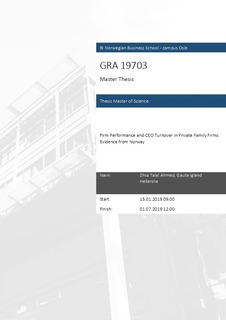Firm Performance and CEO Turnover in Private Family Firms: Evidence from Norway
Master thesis
Permanent lenke
http://hdl.handle.net/11250/2621495Utgivelsesdato
2019Metadata
Vis full innførselSamlinger
- Master of Science [1621]
Sammendrag
In this paper, we examine the relationship between firm performance and CEO
turnover within the dynamics of private firms. More specifically, we will compare
and analyse the differences of CEO turnover in private family firms and private
non-family firms. Our hypotheses revolve around our research question “Is there a
difference between private non-family firms and private family firms in the
sensitivity of CEO turnover to prior firm performance, and, if so, is it a result of a
difference in monitoring?” Each hypothesis builds on existing theories, such as
the classical relationship between firm performance and CEO turnover, agency
theory and the stewardship versus stagnation perspective. At the heart of our
thesis is the analysis of differences in private non-family and private family firms
regarding their CEO turnover to performance sensitivity. Surprisingly, we find
that private family firms are significantly more likely to replace their CEO if
performance is bad than private non-family firms, as measured by lagged return
on assets (ROA). The difference becomes even starker when applying Propensity
Score Matching, further supporting our results. The results are robust to different
empirical models and alternative performance measures. Our findings are
surprising given the well-established longer-term perspective in family firms,
which includes less frequent CEO turnovers on average. Thus, we believe our
results can spur additional discussion on a still limited literature on CEO turnover
in private family firms. Moreover, we analyse whether the CEO turnover decision
is a result of better monitoring. We find that private family firms are less likely to
fire its CEO based on exogenous shocks as measured by industry-wide shocks,
and that firm performance increases significantly more in private family firms
than in private non-family firms following a turnover. Additionally, we find a
significantly negative relationship between prior firm performance and family
firms hiring an outside CEO. In our analysis, we use a comprehensive sample of
182 973 private Norwegian non-family firms and 163 758 private Norwegian
family firms retrieved from the CCGR database. The logistic model is employed
to analyse the relationship between CEO turnover and firm performance, while
the GLS linear regression is used to examine post-CEO turnover performance.
Lastly, we employ the two-stage regression model to assess relative performance.
Beskrivelse
Masteroppgave(MSc) in Master of Science in Finance/(Financial Economics) - Handelshøyskolen BI,2019
